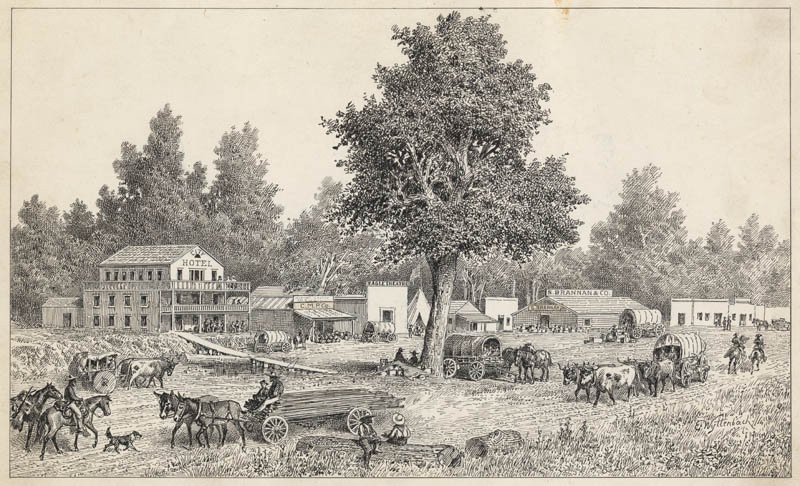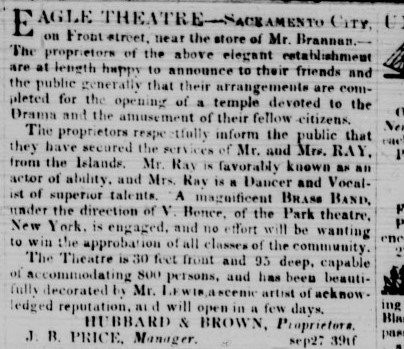Eagle Theatre
Introduction
Text-to-speech Audio
Images
A modern-day view of the Eagle Theatre, which has been constructed as closely as possible to the original--though the structure underwent several remodels in its short life.

An early view of the busy Sacramento waterfront. The Eagle Theatre is just to the left of the large tree in the center of Swiss-born artist Emanuel Wyttenbach's drawing.

One of the Eagle Theatre's earliest advertisements, proclaiming its many comforts and features. Reality proved louder and seedier, given the theatre's proximity to a gambling house and saloon.

Sarah Kirby Stark: California's first female theatre manager. After the destruction of the Eagle Theatre, she joined Atwater's troupe in San Francisco and co-managed the new Tehama Theatre in Sacramento.

A cropped view of Sacramento extracted from a lithograph by French painter and naval surgeon Louis LeBreton. The Eagle Theatre (circled) is partially hidden behind the mainmast of the vessel at far left. J Street runs down the center of the image.

Backstory and Context
Text-to-speech Audio
In 1849, Sacramento was growing rapidly. Only recently wrested from Mexico by the hawkish administration of President James Polk during the Mexican War (1846-48), California was viewed as virgin territory for American settlement when gold was discovered on John Sutter’s estate in 1848. Thousands flooded in from the eastern United States on passenger ships, seeking their fortune in the gold fields, and the sparsely-populated agricultural empire of John Sutter was soon inundated with squatters. His crops devastated and his cattle herds destroyed, Sutter was persuaded by his son to divide the estate into lots and sell it off. These parcels in the elbow of the Sacramento and American Rivers formed the core of the soon-to-be booming city of Sacramento in 1849 and 1850.
The riverbanks of newborn Sacramento were daily awash in people and freight, as ferries offloaded passengers bound for the nearby gold fields and supplies for local merchants. The riverfront was prime real estate, not only for businesses selling goods to would-be miners, but also saloons, gambling houses, and other entertainment venues. Nevertheless, the city lacked a theater until the proprietors of the Round Tent Saloon decided to build a historic first in July 1849.
It did not come cheap. Despite being built of canvas stretched over a wooden frame with a tin roof, the structure cost over $30,000 (a modern cost of nearly $900,000) due to the scarcity of building materials. At such a steep initial investment, small wonder that the new Eagle Theatre underwent four bankruptcies and three changes of ownership in its short lifespan. Nonetheless, despite its poor acoustics, dirt floor, and amateur actors, the theatre opened with fanfare in September of that year, claiming to be “30 feet front and 95 deep, capable of accommodating 800 persons.” The same September 27 newspaper advertisement in the Weekly Alta California (published belatedly on October 4) proclaimed that “arrangements are completed for the opening of a temple devoted to the Drama and the amusement of their fellow citizens.”
Performances first began on September 25, when the Stockton Minstrels performed Ethiopian Concerts. Despite being “well attended” in October during the run of its first dramatic play, The Bandit Chief, the new playhouse must have had difficulty paying for itself. The next changes of ownership occurred in quick succession, because by November 17, 1849 it was already being managed by its final lessee, Mr. J.B. Atwater. Less than two months later, a performance was cut short by violent wind and rain on January 4, 1850--its fateful final performance. Later that month, a catastrophic flood that devastated the similarly ad-hoc structures of Sacramento wrecked the flimsy Eagle Theatre.
Atwater and his troupe briefly set up a theatre on Washington Street in San Francisco at the end of January, but were gone again by the end of the month (somewhat poked at in the San Francisco-based Daily Alta California, who said that “none of them were professional people,” though Atwater was himself an actor who had commanded $60 a night at the Eagle). They returned to Sacramento, this time joined by Sarah Kirby (later Sarah Kirby Stark), and actress Atwater had met in San Francisco. Building had commenced on the new Tehama Theatre in March 1850, two hundred feet east of the Eagle Theatre’s old site (and possibly using some of the old theatre's materials), and began new performances later that month. Sarah Kirby co-managed the Tehama with Atwater, becoming the first female theatre manager in California.
California State Parks, as part of the general effort to restore Old Sacramento as part of national bicentennial celebrations in the 1970s, rebuilt the Eagle Theatre in 1974 to its exact historical specifications, including wooden bench seats and a saloon in the entrance. Since then, it has hosted a multitude of historical, theatrical, and community events, and is at the disposal of the State Parks to support the educational mission of Old Sacramento State Historic Park.
Sources
History of the Eagle Theatre. California State Parks. . Accessed March 25, 2018. https://www.parks.ca.gov/?page_id=27174.
Old Town Sacramento: The Eagle Theatre. California State Parks. . Accessed March 25, 2018. https://www.parks.ca.gov/pages/684/files/eagle.pdf.
First Theaters "California's Gold". Performed by Huell Howser. USA. California Public Television, 2000. Online at Chapman University's Huell Howser Archive.Episode #2001. Aired January 8, 2000. https://blogs.chapman.edu/huell-howser-archives/2000/01/08/first-theaters-californias-gold-2001/
Curry, Jane Kathleen. Nineteenth-century American Women Theatre Managers. Westport, CT. Greenwood Press, 1994. pp.36-39
United States. Work Projects Administration., . (1938). The Starks ; The Bakers ; The Chapmans. San Francisco: W.P.A.. pp.19. Accessed March 25, 2018 through Hathi Trust. https://hdl.handle.net/2027/uc1.31210015240052
Wyttenbach, Emanuel. Sacramento 1849. Between 1877 and 1895. Retrieved from the Digital Public Library of America, http://catalog.library.ca.gov/F/?func=find-b&request=001379147&find_code=SYS. (Accessed March 25, 2018.)Historical newspapers accessed through California Digital Newspaper Collection, 3/25/2018:
Weekly Alta California, Number 40, 4 October 1849 — Page 3 Advertisements Column 4
Weekly Alta California, Number 46, 15 November 1849 — Page 2 Editorial Correspondence Column 2
Daily Alta California, Volume 1, Number 14, 9 January 1850 — Page 2 LOCAL MATTERS Column 4
Daily Alta California, Volume 1, Number 13, 7 January 1850 -- Page 2 THEATRICAL Column 1
Daily Alta California, Volume 1, Number 23, 25 January 1850 -- Page 2 LOCAL MATTERS Column 3
Daily Alta California, Volume 1, Number 76, 28 March 1850 -- Page 2 EDITORIAL CORRESPONDENCE Colum 2
Placer Times, Volume 1, Number 43, 9 March 1850 -- Page 2 RETURN OF MR. ATWATER Column 2
Sacramento Transcript, Volume 1, Number 1, 1 April 1850 — Page 2 TEHAMA THEATRE Column 4
